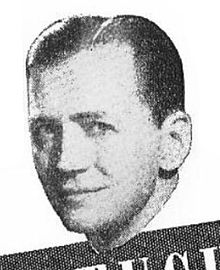Tommy Tucker (bandleader)
| Tommy Tucker | |
|---|---|
 |
|
| Background information | |
| Birth name | Gerald L. Duppler |
| Born |
May 18, 1903 Souris, North Dakota, United States |
| Died | July 11, 1989 (aged 86) Sarasota, Florida, U.S. |
| Genres | Big band, jazz |
| Occupation(s) | Bandleader, music professor |
| Instruments | Piano, accordion, trombone |
| Associated acts | Gerry Mulligan, Eydie Gorme |
Gerald L. Duppler (May 18, 1903 – July 11, 1989), better known under his stage name Tommy Tucker, was an American bandleader.
The Tommy Tucker Orchestra entertained many listeners as a big band in the 1930s and 1940s. Popular as a dance band, the Tucker orchestra played concert halls, theatres, hotels and various venues across the country—for a span of 25 years. Recorded for Okeh in June 1941, his biggest hit, "I Don't Want to Set the World on Fire", achieved status as a Gold Record. Tucker wrote his own theme song, "I Love You (Oh, How I Love You)"; it was published on four record labels, including Brunswick, in 1935, and MGM in 1951.
Many listeners were familiar with the Tucker orchestra sound because they tuned into popular radio shows, such as Fibber McGee & Molly in 1936 and the George Jessel show in 1938, and several shows billed as Tommy Tucker Time. In 1941, Tucker led the orchestra for a New York City version of the Pot o' Gold radio program, which was simulcast on three stations. Tommy Tucker opened each performance—on radio or live—with his signature "tic-toc, tic-toc, it's Tommy Tucker time." And he usually ended each session with Time to Go.
Born Gerald L. Duppler, May 18, 1903, in Souris, North Dakota, he received a Bachelor of Arts at the University of North Dakota in 1924, majored in Music and was recognized as Phi Betta Kappa. Shortly after college, Tucker organized a small band and played at a fairground pavilion in Minot, ND. They played at the Breen Hotel in St. Cloud, MN that winter, and then in the summer of 1926 they played at a popular resort in Detroit, MN—The Pettibone Lodge.
The group began to travel and landed in California. His first recordings were with Crown Records in 1933, under the name Tommy Tucker and His Californians. He used the name Tommy Tucker and His Orchestra for his next recordings for Brunswick in 1935. With Columbia records dominant, Tucker recorded over one thousand sides for over 10 record companies.
Then the band first toured the country, Tucker devised his own marketing approach. When he planned a route, Tucker would send telegraph messages to various towns announcing that he was traveling through the area, and asked if the proprietor of a venue would like to book him. Later in the early thirties, Joe Galkin became the orchestra's official manager who planned all bookings and arrangements for travel.
...
Wikipedia
